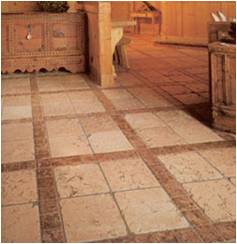 The process for how to clean tumbled marble is worth noting because its characteristics, when compared to other types of marble and natural stone, are very different. This stone has a soft, natural slightly rustic allure for many and deserves special consideration to maintain its appeal.
The process for how to clean tumbled marble is worth noting because its characteristics, when compared to other types of marble and natural stone, are very different. This stone has a soft, natural slightly rustic allure for many and deserves special consideration to maintain its appeal.
The process begins with marble that is literally “tumbled” in a machined procedure. This tumbling of the stone knocks off the edges and roughens its texture to create an “antiqued” affect.
Loving the “Old World” charm found in historic European homes often attracts home owners to the softened edges and imperfect face of tumbled marble. It’s the imperfections of fossils, glass veins, dry seams and pitting on the tile’s surface (exposed through the tumbling process) that defines its character.
It’s these same characteristics that sets cleaning tumbled marble tile apart from other marble tile types by adding an extra step or two.
These imperfections on the stone’s surface, whether occurring naturally, filled at the manufacturer or filled during installation will become loose over time as the tile is exposed to use and normal cleaning.
Filling the Void in Cleaning Tumbled Marble
 The general steps in cleaning marble apply to cleaning tumbled marble with the added task of refilling any voids that have become loosened over time.
The general steps in cleaning marble apply to cleaning tumbled marble with the added task of refilling any voids that have become loosened over time.
Because liquids like water, oil, food acids, and alcohol will “travel” when given the opportunity, they will find any untreated or unfilled voids on a tumbled surface.
If you have tumbled marble in a shower, this provides a perfect opportunity for water to get behind the tile promoting the potential growth of mildew and mold.
There are really only 2 options for filling voids in tumbled tile that have degraded over use — you can fill them with grout or you can fill them with a quality impregnating sealer.
The steps for each are as follows:
Grouting Tumbled Marble “Inclusions”
- If you choose to grout the inclusions in tumbled marble you first need to seal the tile itself — if not already sealed. This will prevent any grout from sticking to the surfaces of the tile face you do not want grouted.
- Choose a sanded grout close to the color of the tumbled tile or the same color as the grout used between the tile. NOTE: If you choose a color that does NOT match that between the tiles then the grout currently installed must be sealed as well.
- Mix the sanded grout to the consistency of a paste and apply to the tile using an inexpensive grout float. Hold the float at a 45-degree angle spreading the grout over the entire tile – make several passes to ensure the grout gets packed into the holes and voids on the tile.
- Turn the grout float to 90-degrees to scrape off any excess grout — this will help push the grout deeper into the inclusions.
 Let the grout start to harden for about 10 minutes and then take a lightly damped grout sponge and wipe off the excess grout. Be sure the grout sponge is not too wet because you don’t want to wash out the grout filled voids and holes. For any larger holes, wipe around them, if possible.
Let the grout start to harden for about 10 minutes and then take a lightly damped grout sponge and wipe off the excess grout. Be sure the grout sponge is not too wet because you don’t want to wash out the grout filled voids and holes. For any larger holes, wipe around them, if possible.- When all the excess has been removed, let the newly grouted voids dry for 24 hours.
Sealing Tumbled Marble Voids and Holes
Leaving any holes or voids exposed in tumbled marble tile, while certainly adding more dimension to the tile’s appearance, need more frequent maintenance if not grouted and certainly is an owner’s option.
To seal unfilled inclusions, follow these recommendations:
 Find a high quality impregnating sealer and using a paint sponge, brush the sealer over the surface of the tumbled marble tile.
Find a high quality impregnating sealer and using a paint sponge, brush the sealer over the surface of the tumbled marble tile.- Use overlapping strokes from side to side and top to bottom to ensure the sealer penetrates holes, veins and voids.
- Let the sealer penetrate the tumbled marble for a minimum of 10 minutes to make sure it’s absorbed.
- Using a clean, lint-free cloth, buff the surface of the tumbled tile to remove any excess sealer not absorbed by the marble.
- Rub in a circular motion until the tiles are dry and not “tacky” to the touch.
Remember that an impregnating sealer will not completely waterproof your tile. It will buy you time to remove any offending agents.
Because sealer will wear with use and cleaning, only applying an impregnating sealer (as your preferred method for how to clean tumbled marble tile) may not last as long as sealed, grout-filled inclusions.
Depending on where your tumbled marble is located, and how much it is at risk for marble staining, should be a consideration on whichever method you use for cleaning and maintaining any voids or exposed, worn corners or edges.




